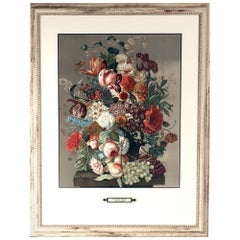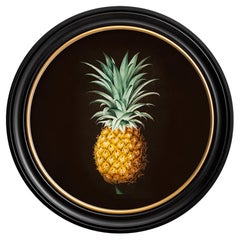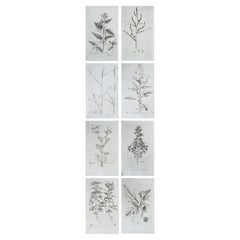Joseph Nigg Wall Decorations
to
1
1
Height
to
Width
to
1
1
1
1
1
1
1
1
1
435
301
286
282
Creator: Joseph Nigg
Botanical Large Print After Joseph Nigg, from the Ateliers Lithographiques Mourl
By Joseph Nigg
Located in Downingtown, PA
Botanical Print after the painting of the Austrian painter, Joseph Nigg, (1782-1863)
Artist: Joseph Nigg (1782-1863)
Medium: Lithograph
Dimensions: 39 3/4 inches high x 31 i...
Category
1940s Georgian Vintage Joseph Nigg Wall Decorations
Materials
Paper
Related Items
Pineapple botanical study framed Print from French original of 1812, New
Located in Lincoln, Lincolnshire
This is a delightful round framed print of a Pineapple study originally from a hand coloured early 19th Century French botanical illustration.
Prints of this style were originally p...
Category
2010s British Georgian Joseph Nigg Wall Decorations
Materials
Glass, Wood, Paper
$290 Sale Price
20% Off
H 1.58 in Dm 17.33 in
Set of 8 Original Antique Large Scale Botanical Prints. Dated 1791
Located in St Annes, Lancashire
Wonderful set of 8 botanical prints.
A beautiful colour of off-white/cream to the paper.
Dated 1791
Originally from " Flora Londinensis " published by William Curtis
Copper-plat...
Category
1790s English Georgian Antique Joseph Nigg Wall Decorations
Materials
Paper
$500 / set
H 18 in W 11 in D 0.07 in
Set of 12 Original Antique Large Scale Botanical Prints. Dated 1791
Located in St Annes, Lancashire
Wonderful set of 12 botanical prints.
A beautiful colour of off-white/cream to the paper.
Dated 1791
Originally from " Flora Londinensis " published by William Curtis
Copper-pla...
Category
1790s English Georgian Antique Joseph Nigg Wall Decorations
Materials
Paper
$750 / set
H 18 in W 11 in D 0.07 in
1871 Botanical Prints of Paeonia and Butomus from Tunbridge Wells Flora
Located in Langweer, NL
1871 Botanical Prints of Paeonia and Butomus from Tunbridge Wells Flora
Offered here is a striking pair of original 19th-century botanical prints from The Flowering Plants of Tunbridge Wells and Neighbourhood by Richard Deakin, published in 1871 by Stidolph & Bellamy and Groombridge & Sons, London. These finely detailed plates depict Paeonia corallina (Coral Peony) and Butomus umbellatus (Flowering Rush), two elegant flowering species native to parts of Europe and found in the Tunbridge Wells region of England.
Rendered with scientific precision and colored by hand, these prints reflect the Victorian era’s passion for botany, natural classification, and the visual arts. Each flower is represented in its full structural form, with careful attention to botanical accuracy, showing stems, leaves, blossoms, and reproductive parts where applicable.
The *Paeonia corallina* features deep crimson petals and vibrant green foliage, while the *Butomus umbellatus* is notable for its light pink clustered blooms atop tall, sinuous stems—its root and bulb details meticulously illustrated alongside. These prints exemplify the dual nature of botanical works of the 19th century: simultaneously scientific documents and refined decorative art.
These plates come from one of the more specialized and regionally focused British botanical publications of the period, making them relatively rare in the market. Their historic link to the Tunbridge Wells flora gives them additional geographic and academic interest.
Condition Report:
Good condition overall. Hand-coloring remains vivid and precise. The paper shows only minor, even toning, appropriate for its age. No significant foxing or tears. Species names are present and clearly legible.
Framing Suggestions:
For the best visual impact and preservation, these prints should be framed in matching frames with archival mats and UV-protective glass. A neutral mount (ivory or pale grey) will complement the organic colors while enhancing their Victorian charm. Ideal for hallways, libraries, studies, or conservatories, especially in botanical or period-themed interiors.
Keywords:
Victorian botanical prints...
Category
1870s Antique Joseph Nigg Wall Decorations
Materials
Paper
$154 / set
H 21.5 in W 13.5 in D 0.02 in
Exotic Botanicals and Rare Butterflies – Hand-Colored Dutch Prints from 1775
Located in Langweer, NL
Very good condition. Original hand coloring remains vivid, particularly in the greens and butterfly markings. Slight age toning and a few natural paper spots consistent with 18th-cen...
Category
Late 18th Century Dutch Antique Joseph Nigg Wall Decorations
Materials
Paper
$643 / set
H 16.93 in W 10.83 in D 0.01 in
Exquisite Botanical Illustrations from Curtis’s Botanical Magazine (1847)
Located in Langweer, NL
These beautiful hand-colored botanical illustrations, drawn and lithographed by the renowned artist Walter Hood Fitch, were featured in Sir William Jackson Hooker's *"Curtis's Botanical Magazine,"* published in London in 1847. Fitch was one of the most prolific and skilled botanical illustrators of the 19th century, known for his ability to capture the intricate details and vibrant hues of the plants he depicted.
Sir William Jackson Hooker, a famous British botanist and the director of the Royal Botanic Gardens, Kew, commissioned these illustrations as part of his work to document newly discovered plants from around the world. The *Curtis’s Botanical Magazine* has been published since 1787 and remains one of the longest-running botanical periodicals.
Detailed Descriptions of Each Plant
#### 1. **Dipladenia Rosa-campestris** (*Hortul. ex Veitch*)
- **English Name**: Rose Dipladenia
- **Description**: This illustration showcases *Dipladenia rosa-campestris*, a striking flowering plant known for its showy pink to deep red trumpet-shaped flowers. Native to tropical regions of South America, particularly Brazil, *Dipladenia* belongs to the family Apocynaceae and is prized in horticulture for its vibrant blooms and ability to climb. Fitch's illustration emphasizes the waxy leaves and the vivid color of the petals, bringing the plant to life on the page.
#### 2. **Begonia fuchsioides** (*Hook.*)
- **English Name**: Fuchsia-flowered Begonia
- **Description**: The *Begonia fuchsioides* is depicted with its characteristic red, pendulous flowers, which closely resemble the blooms of fuchsia plants. This species of Begonia is native to tropical regions and is popular for its delicate, bell-shaped flowers and glossy leaves. Fitch’s attention to the arrangement of the leaves and the contrast between the flowers' vibrant red and the soft green leaves provides a lifelike representation of this exotic plant.
#### 3. **Agalmyla staminea** (*Blume*)
- **English Name**: Staminate Agalmyla
- **Description**: This illustration captures the unique red tubular flowers of *Agalmyla staminea*, a plant native to Southeast Asia. The species is part of the Gesneriaceae family and is known for its bright, showy flowers that grow in dense clusters. Fitch’s careful rendering of the plant’s leaves and the intricate veining, along with the vibrant red flowers, highlights his talent for bringing the botanical subject to life with both scientific accuracy and artistic flair.
### About the Makers
#### **Walter Hood Fitch** (Artist and Lithographer)
Walter Hood Fitch (1817–1892) was one of the most influential botanical artists of the 19th century, working primarily with Sir William Hooker and later his son, Joseph Dalton Hooker, at Kew Gardens. He produced thousands of illustrations for various botanical publications, including *Curtis’s Botanical Magazine*, where he was responsible for the majority of its plates from 1834 to 1877. Fitch’s mastery of lithography allowed him to create richly detailed and accurate depictions of plants, with a particular talent for illustrating both the botanical structure and the vibrant colors of flowers.
#### **Sir William Jackson Hooker** (Director and Editor)
Sir William Jackson Hooker (1785–1865) was a prominent British botanist and the director of the Royal Botanic Gardens, Kew. Under his leadership, Kew Gardens expanded its collection of plants from around the world, and Hooker was instrumental in promoting the scientific study and illustration of these species. As the editor of *Curtis’s Botanical Magazine*, Hooker collaborated with Fitch to document and share the beauty and diversity of plants with the scientific community and the public.
### The Lithographic Technique
Lithography, particularly chromolithography, was a crucial innovation in botanical illustration. Fitch was skilled in the traditional method of lithography, where an image was drawn onto a stone plate with a greasy substance and then inked for printing. Hand-coloring was often applied afterward to bring the prints to life, as seen in these illustrations. This method allowed for highly detailed, accurate representations of plants and their botanical features, making it invaluable for both scientific study and aesthetic appreciation.
### Conclusion
These prints from *Curtis’s Botanical Magazine* reflect the height of botanical art in the mid-19th century. The combination of Walter Fitch...
Category
1840s Antique Joseph Nigg Wall Decorations
Materials
Paper
$409 Sale Price / set
20% Off
H 9.53 in W 6.46 in D 0 in
A Walnut Framed Botanical Picture Printed by C Hall Mandel, 'Drawn from Nature J
Located in Bishop's Stortford, GB
A Walnut Framed Botanical Picture Printed by C Hall Mandel, 'Drawn from Nature J & E Gould' This exquisite framed picture featuring Strawberries meticulously crafted to showcase vibr...
Category
Late 19th Century British Victorian Antique Joseph Nigg Wall Decorations
Materials
Walnut
$315
H 18.51 in W 14.57 in D 1.19 in
Large Pair of Original Antique Botanical Prints, Dated 1838
Located in St Annes, Lancashire
Wonderful pair of botanical prints.
Lithographs by Alfred Adlard
After C.W Harrison
Original hand color
Published, 1838
Unframed.
The me...
Category
1830s English Chinoiserie Antique Joseph Nigg Wall Decorations
Materials
Paper
Floral Treasures: 19th-Century Chromolithographs from the Botanical Collection
Located in Langweer, NL
The following six chromolithographs are part of a collection published in 1896, created by Désiré Bois and Edward Step. They illustrate botanical subjects with remarkable attention t...
Category
1890s Antique Joseph Nigg Wall Decorations
Materials
Paper
$514 Sale Price / set
20% Off
H 9.45 in W 6.11 in D 0 in
Antique Botanical Prints: Bouvardia Longiflora, Crossworts & Large Spur Valerian
Located in Langweer, NL
Trio of Antique Botanical Prints: Bouvardia Longiflora, Crossworts & Large Spur Valerian
This elegant set of antique botanical prints features three unique plants: "Bouvardia Long...
Category
1890s Antique Joseph Nigg Wall Decorations
Materials
Paper
$381 / set
H 9.45 in W 6.11 in D 0.01 in
Botanical Print, Corona Imperialis Polvanthus, After Basil Besler
By Basilius Besler
Located in Bradenton, FL
The hand-colored botanical print, Corona Imperialis Polyanthos or Crown Imperial Lily, was originally by Basil Besler (1561-1629) a Nuremberg, Germany pharmacist, and published in t...
Category
20th Century German Baroque Joseph Nigg Wall Decorations
Materials
Paper
Detailed Botanical Engraving of the Coffee Plant from Histoire Naturelle, c.1780
Located in Langweer, NL
This engraving titled "Histoire Naturelle: le café" is a detailed botanical illustration, part of an 18th or 19th-century natural history text or compendium.
It depicts the coffee ...
Category
Late 18th Century Antique Joseph Nigg Wall Decorations
Materials
Paper
$152 Sale Price
20% Off
H 10.04 in W 7.52 in D 0 in
Joseph Nigg wall decorations for sale on 1stDibs.
Joseph Nigg wall decorations are available for sale on 1stDibs. These distinctive items are frequently made of paper and are designed with extraordinary care. If you’re looking for additional options, many customers also consider wall decorations by george brookshaw, Francois Nicolas Martinet, and Johann Wilhelm Weinmann. Prices for Joseph Nigg wall decorations can differ depending upon size, time period and other attributes — on 1stDibs, these items begin at $1,850 and can go as high as $1,850, while a piece like these, on average, fetch $1,850.


